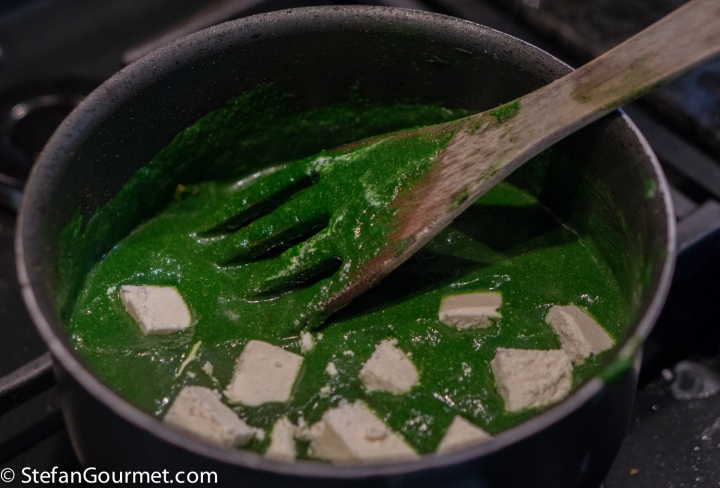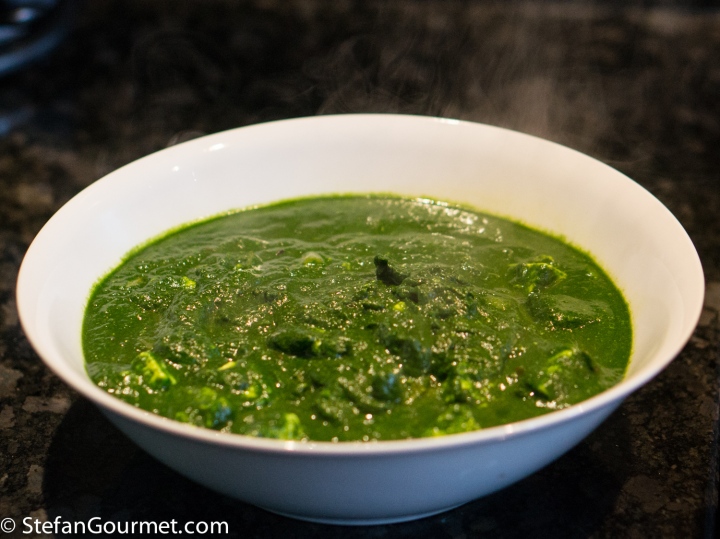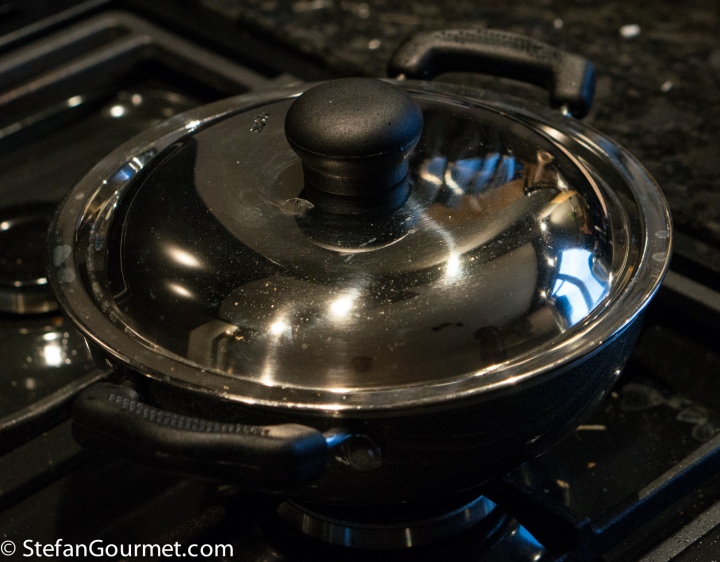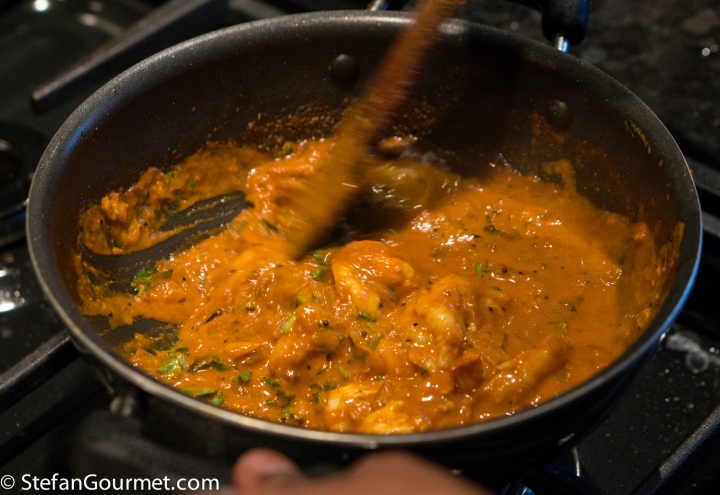I’ve never been to India and I’ve never even eaten at an Indian restaurant. But I was curious about the cuisine, and so it was a great pleasure that two natives, Vinod and Seema, were willing to cook for me and show me how Indians cook at home. Of course India is a large country with many regional differences, and every household prepares the dishes a bit differently and some spices will be different. Vinod and Seema prepared four different dishes while I was watching, taking photos, and asking questions, and all of them were delicious. In this post I will share what I’ve learned to my best ability. Although I am not familiar with all the ingredients and spices, luckily the cooking technique did make sense.
Spices are an integral part of Indian cuisine. These are the spices they use the most: chilli powder, ground coriander, mustard seed, ground cumin, turmeric, cumin seed, and garam masala. The latter is a mix of ground spices: black and white peppercorns, cloves, cinnamon or cassia bark, nutmeg, mace, black and green cardamom pods, bay leaf, and cumin.
Dal
The first dish was dal, lentils. First the yellow lentils were pressure cooked with asfoetida, which is added as a digestive aid, fresh green chillis, ground turmeric, and salt.
While the lentils are cooking, the ingredients to add to the lentils later on were prepared: tomato, curry leaves, dried red chillis, cilantro, shallot, and garlic.
When the lentils were done…
…the tomato was added.
The shallots, garlic, chilli peppers, curry leaves, were sautéed in some oil together with cumin seed and mustard seed.
This mixture was added to the lentils, together with some water.
Finally, some lime juice was added…
…and fresh cilantro.
Palak Paneer
The second dish was paneer, Indian fresh cheese, with spinach. First the spinach was cooked with only a bit of water until just starting to wilt…
…and then chilled in ice water to stop the cooking and keep the color.
The spinach was then put in a blender with salt, fresh green chilli, fresh cilantro, and fenugreek leaves (which were frozen, as they are difficult to obtain fresh in the Netherlands). This was then blended to a puree.
[To get fresh fenugreek leaves, you can plant some dried fenugreek seeds and grown your own. According to Vinod it takes only 2-3 weeks for them to grow to 15 cm (6 inches), which should be good enough to use.]
Cumin seed, garlic, and shallot were sautéed in a bit of oil.
Then ground turmeric and ground coriander were added.
The spinach puree was added to this, together with some yogurt and water.
Then the paneer was cut into pieces and added together with some lime juice.
The pot was covered for a couple of minutes to allow the paneer to heat through over low heat.
Then the Palak Paneer was served in a bowl…
…and garnished with yogurt and cream.
Chicken curry
Vinod and Seema know what they are doing, because they used chicken thigh instead of chicken breast meat. The chicken was marinated in yogurt, salt, chilli powder, and turmeric.
First the oil was flavored by cooking some spices in it for a couple of minutes: bay leaf, cloves, cardamom pods, star anise, and cinnamon bark.
Next, onion was added and sautéed.
Then the spices were removed, and subsequently ground coriander, ground cumin, chilli powder, and garam masala were added. As well as some tomato paste, and a paste of ginger and garlic.
Then the chicken was added, together with fresh tomato and some salt. The chicken was cooked for a few minutes in the masala until it started to release some juices.
When the chicken started to release juices, water was added.
To thicken the curry, first some cashew nuts were pounded in a mortar with a pestle.
Then some yogurt was added as well. Cashews and yogurt do not only thicken the curry, but also mellow it down a bit.
Then we went outside for a technique to smoke the dish that I had not seen before. Vinod built a small fire with some charcoal.
When the charcoal was covered by white ash, he took a piece of charcoal back to the kitchen and put it on top of the curry on a small aluminum dish, and put a bit of butter with some saffron threads on top. The butter started smoking a lot. The pot was covered to smoke the dish while the chicken finished to cook.
Finally, the charcoal was removed and the curry was garnished with fresh cilantro.
Shrimp curry
For the shrimp curry, some green chilli, garlic, mustard seed, and curry leaves were sautéed in some oil.
Then a chopped onion was added.
Followed by tomato paste as well as garlic and ginger paste, chilli powder, turmeric, ground cumin, ground coriander, and a bit of garam masala.
Then water, coconut milk, and tamarind paste were added.
Vinod mentioned that he wanted to keep the shrimp moist. I suggested to add the raw shrimp to the hot curry and turn off the heat and cook the shrimp that way.
And so we did, covered for a couple of minutes until the shrimp was just cooked through but still juicy.
Finally some fresh cilantro and lime juice were added.
And the shrimp curry was ready.
This has been a wonderful experience and I will be sure to try cooking some Indian dishes on my own.
Flashback

Saucijzenbroodjes (sausage rolls) are a very popular snack in the Netherlands. I don’t like the regular version very much and prefer my own ‘Italian’ version.







































What a treat. I am amazed that you have never been to an Indian restaurant. Are there not many in the Netherlands? I love Indian food and grew up with it as there is a large Indian population in South Africa.
LikeLiked by 1 person
Nice dishes! If you continue with Indian food, for sure do not use ground spices. Use whole spices and buy a cheap coffee grinder to grind the, then per-dish, dry toast them in a pan and then grind. You get a dramatically nice flavour and the spices are cheaper as seed and last longer.
I have a similar daal recipe but I use red lentils, which cook quickly and easily without the pressure cooker.
LikeLiked by 1 person
Lovely recipes, lovely photos … thank you Stefan.
LikeLiked by 1 person
Two words. Butter Chicken.
LikeLiked by 1 person
You can’t get a better introduction to Indian cooking than that! And what a clever smoking technique, I’ve never seen that done before. Thanks for sharing.
LikeLiked by 1 person
Two more words. Vermicelli kheer. They must make this dessert for you. It’s my favorite!
LikeLiked by 1 person
Questo è un corso per un pasto completo. Bellissime ricette.
🙂
LikeLiked by 1 person
Okay, this is my last one, 🙂 Burfi, any kind. It’s a Northern Indian sweet, kinda like fudge.
LikeLiked by 1 person
The description can’t be better. Thanks Stefan. I learnt something .
LikeLiked by 1 person
Interesting trick with the smoked butter and saffron… I’ve not seen that before!
LikeLiked by 1 person
How lucky you are! All of these dishes sound wonderful, and it must have been such a treat to be cooked for!!!
LikeLiked by 1 person
I love, love, love Indian food, mild all the way to super hot! How wonderful for you to have friends who have gone the whole nine yards for you. Very yummy post! 🙂
LikeLiked by 1 person
That smoking technique was very, very clever. Bravo.
LikeLiked by 1 person
Having just ventured into Indian cuisine myself, I really enjoyed this post! It’s a heck of a lot easier to make than I thought it would be! Can’t wait to see what you come up with when you try it yourself Stefan! 🙂 🙂
LikeLiked by 1 person
Che bello! Non ho mai mangiato niente di indiano!
LikeLiked by 1 person
What a fantastic introduction to Indian food, Stefan! Smoking the chicken with that technique is entirely new to me, fascinating!
LikeLiked by 1 person
Great looking dishes Stefan, how generous of your friends to step you through the preparation. Freshly roasted and ground whole spices make an enormous difference to the end flavour. Try it out, then plan a trip to India, it’s an amazing destination, you’ll return over and over again
LikeLiked by 1 person
Reading this as a channa masala is simmering on the stove. Love Indian cooking and it’s the only ethnic food that is at best passable in Los Angeles. Whenever I am back in London, I have Indian nearly every day.
LikeLiked by 1 person
Yippee! Well, politely said, thank you! Wonderful! Both husbands [one Estonian, one Hungarian] lived on Indian food . . . must know a wee bit 🙂 ! Great you have people who obviously ‘know’ helping you!! With your sense of food curiosity, please keep on!!! By the bye and of no importance: I make a big pot of various kinds of dhal every week – I do not use butter or that wretched thing called ‘margarine’ on almost anything, but ‘cooked down’ dhal, placed into ramekins, frozen, and then later used to go on toast, flatbreads or anything else healthy carb is just stupendous 🙂 ! Thank you for coming ‘our’ way!!
LikeLiked by 1 person
My mouth is watering, Stefan. I was brought up in India and just loved their food and the people.
LikeLiked by 1 person
Amazing experience Stefan. I find it funny that at the end of this hugely complicated post there is a flashback on sausage rolls.
LikeLiked by 1 person
Those sausage rolls were made with homemade puff pastry, so in a way they were more complicated than the Indian food 😉
LikeLiked by 1 person
These recipes look amazing – I love South Asian food. I used to eat it a lot when I lived in Birmingham but haven’t so much in recent years. I am definteyl going to make these – thank you
LikeLiked by 1 person
Those dishes look delicious. I love the sauces that go with Indian food. I could eat them all by themselves.
LikeLiked by 1 person
Dear Stefan thanks a lot, I really love Indian food. I’m printing the recipies and I’m looking forward to cooking them. Good night 🙂
LikeLiked by 1 person